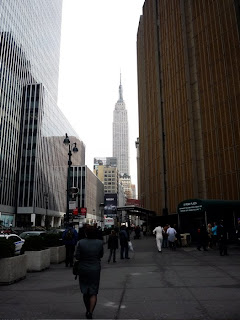A Pre-War Legend in Post-War New York
 In October of 1953, two years after becoming a U.S. citizen, film legend Greta Garbo bought a spacious apartment in The Campanile at 450 E. 52nd St. A building of understated elegance by today's standards, the apartment building served the needs of discreet older New York families as well as other movie stars. The building, which takes its architectural inspiration from the counterpart in Venice's Piazza San Marco, sits at the far quiet south end of the street and with views overlooking the East River. Garbo lived on the fifth floor with a view of the river and the Queensboro Bridge, and she decorated her seven rooms with attractive antiques and art.
In October of 1953, two years after becoming a U.S. citizen, film legend Greta Garbo bought a spacious apartment in The Campanile at 450 E. 52nd St. A building of understated elegance by today's standards, the apartment building served the needs of discreet older New York families as well as other movie stars. The building, which takes its architectural inspiration from the counterpart in Venice's Piazza San Marco, sits at the far quiet south end of the street and with views overlooking the East River. Garbo lived on the fifth floor with a view of the river and the Queensboro Bridge, and she decorated her seven rooms with attractive antiques and art.From 1953 until her death on April 15, 1990, she spent much of her time walking the nearby streets. She typically took a walk in the morning and then another in the afternoon after lunch. Sometimes a friend would accompany her, and at other times she was content to stroll alone. Her biographers describe several of her favored routes. She liked to walk up 3rd Ave. to visit the antique shops, but she also frequented 1st and 2nd Avenues. She often walked north on Madison Avenue to look at art galleries or over and down to the Waldorf Astoria to meet a friend for lunch. From her starting point at the east end of 52nd St. she would also walk to wherever the mood struck her. She would window shop or browse stores, and on a few occasions she bought something. Shopkeepers found her cordial.
In an attempt to capture the paths of this most famous fellow flâneuse, I followed in her footsteps over the past few days. Beginning at her apartment building at 450 E. 52nd St., I set out to see what Garbo might have seen, to envision as best I could the changing landscapes she may have encountered over a period of 35 years. I walked to a few of her known destinations, such as the Waldorf and the Museum of Modern Art, but I have no idea the specific route she chose. I am guessing that she was of the sort to improvise variations on the same path.
What struck me most was the idea that she was a pre-war movie star walking into post-war New York. From the vantage point of walking from east to west along 52nd Street, Garbo walked from the old world of a flickering cinematic memory into the brave new world of mid-century - the Seagram Building (1957) and the Lever House (1951-1952), the Colgate Palmolive Building (1955), and the Union Carbide Building (1960). Greta Garbo, the most famous face on nitrate, chose to spend her notorious retirement at the dawn of a glassier, taller, quintessentially modern, and increasingly bureaucratic city that redefined New York. This was the fifties world of "the lonely crowd" and "the man in the gray flannel suit" and the dawn of television. For an independent and self-reliant woman in her late forties and in search of some solitude, she made the perfect choice.
Image: Greta Garbo photographed in 1924 by Henry B. Goodwin (1878 - 1931)
See the full Greta Garbo postings on these special WOTBA pages here.





I can imagine the excitement and awe of many native New Yorkers and perhaps even visitors seeing a beautiful legend such as Greta Garbo walking along the street. At the same time she was a discreet person who ventured out into the public hoping to remain anonymous. I don't think there can ever be a movie star of her type again.
ReplyDelete